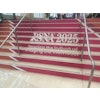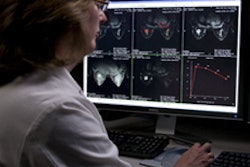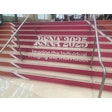Breast MRI screening is a relatively painless exam for patients in clinically indicated populations. But getting paid for breast MRI screening can be a headache for providers, especially those who aren't familiar with negotiating a jungle of rules and requirements.
Breast MRI has become an accepted screening tool for high-risk women, especially since the American Cancer Society (ACS) gave the technology a vote of confidence in 2007 by adding it to its breast cancer screening guidelines. But many payors appear to be dragging their feet when it comes to paying for breast MRI exams.
Reimbursement for breast MRI screening varies by insurance provider, individual insurance policy, geographic location, and not infrequently, the lack of understanding of the diagnostic value of the procedure by an employee of a third-party radiology benefits management company.
"Medicare reimburses very favorably for breast MRI procedures. However, only about 9% to 10% of the revenue for all women's imaging-related procedures is received from Medicare and Medicaid," according to Barbara Ossias, a reimbursement consultant and principal of Reimbursement Revenue Solutions of Middletown, MD. For breast MRI screening, government revenue is estimated at less than 1%.
“Reimbursement for a breast MRI screening ... has improved
markedly in the past
several years.”
— Barbara Ossias,
Reimbursement Revenue Solutions, Middletown, MD
For this reason, it's anyone's guess as to the number of breast MRI screenings performed in the U.S. Private insurance companies do not disclose their statistics, either for the procedures they approve or the ones they deny. This makes reporting of reimbursement for breast MRI screenings anecdotal at best.
"Based on my own analysis, reimbursement for a breast MRI screening of an asymptomatic but high-risk patient has improved markedly in the past several years," Ossias said. "The American Cancer Society's guidelines have had a very positive impact with an increasing number of national and regional health insurance companies."
In March 2007, the ACS issued new guidelines recommending that women with more than a 20% lifetime risk of breast cancer have an annual breast MRI as well as an annual mammogram. In the U.S., an estimated 1.4 million to 1.6 million women meet the criteria. Because no statistics are published, neither the ACS nor any other professional or government organization that tracks diagnostic imaging utilization knows how many of these women request the exams, and from these, how many requests are accepted or denied.
The first hurdle: Negotiating payment
How much do private payors pay for breast MRI screening exams? Ossias said that the range she has heard for reimbursement from her company's clients ranges from $600 to $1,600.
Ossias recommends that when negotiating with a private payor, a healthcare center should determine in advance what its total costs are for both the technical and professional components. The technical fee should include all the costs related to performing the exam, including contrast and administrative expenses.
To calculate the professional fee, a center must estimate the percentage of breast MRI procedures that it expects to perform that are for screening, compared to those that are diagnostic. Radiologists experienced in reading breast MRIs say that they can review a screening exam in five to 10 minutes, whereas a diagnostic exam will require 20 to 60 minutes. Since interpreting a breast MRI exam can have only a single fee associated with it, it is important that the fee proposed accurately represent this mix.
Reimbursement Revenue Solutions provides detailed information about payment rates and variables to providers in their geographic region. Providers also are informed of the specific policies and reimbursement procedures of private payors.
Health insurance companies and managed care providers start negotiations low, according to Ossias, and providers should not automatically accept the first reimbursement offer they receive. Private payors will start negotiations at or below the usual and customary charge (UCC) fee schedule published by Practice Management Information, a Los Angeles-based publisher that compiles payment data.
"UCC payments are the rate a provider will receive if the procedure billed is not covered under a contract between the facility and the payor. Contrast agents are usually reimbursed at cost," Ossias explained.
"If a center enters negotiations with an insurance company or managed care company knowing the costs that it will incur, it may be in a stronger position," she said.
While most centers interviewed by AuntMinnie.com stated that the payment they receive is fair or profitable, insurance companies that dominate the private health insurance market in some areas may strike a very hard bargain. Several centers said that they weren't able to meet demand for breast MRI screening that they know exists in their communities due to reimbursement issues.
Documentation is key
If a woman meets the ACS guidelines for being classified as a high-risk patient, her insurance policy must then be reviewed to determine if the published policy covers her situation. In addition to the published policy of an insurance company, such as Aetna, Cigna, or UnitedHealthcare, it is imperative to check the specific policy issued by the insurance company, as coverage may differ.
The next step is to obtain precertification, even if it is not specified as a requirement for reimbursement, Ossias recommends. "Don't assume anything, and do document everything," she said.
She recommends that providers communicating with insurance companies and radiology benefits management companies document the telephone number they called, the date and time of the call, and the people they talked with and their title, and keep notes of the conversation. Providers should request that a copy of the precertification approval be sent by fax or e-mail. They also should verify at the time of precertification exactly what documents or information about the patient they will need to submit.
When talking with an insurance company, providers also need to ask if "gatekeeper" approval is also needed, and if so, document the call and request a copy of that precertification. "An insurance company representative may not advise that their gatekeeper approval is also needed, and claims are denied for this reason," Ossias said.
Even if precertification is received, the process is comprehensively documented, and all necessary information is submitted, it doesn't mean that payment will be made in a timely manner, or even at all. The insurance program of one large retail chain automatically sends all breast MRI screening claims it has precertified for additional medical review. Payments average at least six months from the submission date of the claim, according to one center claims manager, who noted that there is no logical reason for 100% of preapproved breast MRI screenings to require clinical review.
Some center operators stated that as long as they adhered to health insurance companies' criteria, they were paid without hassle. Others reported the need to spend many hours on the phone and provide additional documentation that had not originally been requested to obtain reimbursement.
A number of insurance companies do not pay for a breast MRI screening procedure that has been precertified if a cancer is not found. One radiologist commented with frustration that "you can't bill the patient because you have told them that their insurance company has approved the exam. So you absorb the cost, and then try to determine if the next patient with the same insurance policy should be told that they are ultimately responsible for paying, or if you take another chance."
A particularly frustrating point is that sometimes payment is not made for one patient but is for another in which the policy, the patient's risk level, and the process of precertification and documentation are identical, the radiologist said.
At this point, reimbursement administrators say, it is time to get on the phone and start calling. This can represent an escalating administrative expense that is not factored into the negotiated fee. With enough persistence and documentation, the provider gets paid.
The positive news is that with many insurance companies, once a medical director gets to know that a particular provider will screen only high-risk women, the hurdles may be eliminated.
Why the hassle? Reimbursement managers state that some insurance companies haven't adequately trained their staff. But denial after approval is regularly occurring with specific insurance companies representing specific regions of the U.S., although no one knows the true magnitude of the problem.
The role of BRCA1 and BRCA2 testing
There is one exception to the uncertainty of reimbursement for breast MRI screening. Exams for patients who have tested positive for the BRCA1 and BRCA2 gene mutations -- who have a 60% to 80% risk of developing breast cancer in their lifetime -- receive unquestioned and generally hassle-free reimbursement.
The catch for the patient is whether that individual is willing to pay the approximately $2,800 cost for the genetic testing if it's not covered by their current health insurance provider, and whether they want to publicly reveal this fact if they do test positive for fear of future health insurance company policy exclusions.
The good news about the DRA
The Deficit Reduction Act (DRA) of 2005 has devastated large segments of the outpatient imaging market, with its drastic reimbursement cuts. Miraculously, however, the DRA has largely left unscathed reimbursement for current procedural terminology (CPT) codes for unilateral (CPT 77058) and bilateral (CPT 77059) breast MRI exams. Mammograms are also similarly exempt. The contrast agents used in breast MRI exams (HCPCS A9579) tend to be paid at actual cost.
The bad news about breast MRI CAD
For many radiologists, breast MRI computer-aided detection (CAD) is an essential component used to review and accurately make diagnoses of breast MRI procedures. Until June 30, 2006, reimbursement could be claimed using category I CPT codes 76377 (3D reconstruction) and 76350 (image subtraction).
These have been replaced by CPT code 0159T, described as computer-aided detection, including computer algorithm analysis of MRI image data for lesion detection/characterization, pharmacokinetic analysis, with further physician review for interpretation breast MRI.
Few health insurance companies are believed to reimburse for this code, citing it as experimental, according to Dr. Bruce Porter, medical director of First Hill Diagnostic Imaging in Seattle. The American College of Radiology (ACR) strongly recommends that providers claim the code with every payment submission when it is utilized, as this now is the only method of documenting the use of breast MRI CAD.
Accreditation requirements
Meanwhile, accreditation of dedicated breast MRI centers and/or women's imaging centers is rapidly becoming a requirement for reimbursement. Hospitals and imaging centers with MRI equipment that is used for many different procedures, including MRI, are typically accredited by either the ACR or the Intersocietal Commission for the Accreditation of Magnetic Resonance Laboratories (ICAMRL), a division of the Intersocietal Accreditation Commission (IAC) in Columbia, MD.
The commission is the only national organization that offers accreditation for breast MRI, and the cost for three-year accreditation is $2,700. In August 2008, Breast MRI of Oklahoma in Oklahoma City became the first dedicated breast MRI imaging center to receive ICAMRL accreditation.
Private payors who require accreditation include Highmark Blue Cross Blue Shield of Pennsylvania, and UnitedHealthcare will require accreditation of freestanding imaging centers and/or provider clinics in its network beginning in the fourth quarter of 2009. The concept of MRI accreditation got a further boost from the Medicare Improvements for Patients and Providers Act of 2008, which requires that providers of advanced diagnostic imaging services be accredited by 2012 as a condition to receive Medicare and Medicaid reimbursement.

“The IAC recognizes that medical staff acquire their expertise by more than one means, and our requirements offer several pathways to meet the requirements.”
— Sandy Katanick,
Intersocietal Accreditation Commission, Columbia, MD
Fortunately, accreditation is a straightforward process. If a healthcare facility is already accredited for MRI, it is unnecessary to apply for breast MRI. Women's health clinics that only perform breast MRI procedures will be accredited only for breast MRI. They do not need to become accredited for other types of MRI procedures they do not perform.
Components for accreditation include medical and technical staff requirements, physical facility requirements focusing on safety and privacy, exam interpretation, reports and recordkeeping requirements, and quality assurance and preventive maintenance requirements. The ICAMRL's accreditation protocol is to ensure that freestanding outpatient facilities meet nationally recognized quality and safety standards for performing breast MRI examinations.
"The IAC recognizes that medical staff acquire their expertise by more than one means, and our requirements offer several pathways to meet the requirements," explained Sandy Katanick, IAC's chief executive officer.
A medical director is required to have interpreted a minimum of 1,000 breast MRIs, working in this specialty for a minimum of five years and completing 150 hours of category 1 CME relevant to breast MRI over the course of a career. Or, the physician must complete a residency or fellowship with MRI experience as an integral component, and have interpreted a minimum of 150 cases specific to breast MRI.
Medical staff must have interpreted a minimum of 500 exams, worked in the specialty for a minimum of three years, and completed the same CME requirements. The interpretation capabilities of each radiologist are evaluated based on the accuracy, clarity, comprehensiveness, and content elements required by the ICAMRL in reports. Three exams must be submitted on a CD with a DICOM viewer, and include all the acquired images in the exam, plus any 3D or subtractions used. One exam must have normal findings; the others need to demonstrate two different pathologies.
Technical staff also are offered a selection of criteria, including being credentialed in MRI, having one year of full-time MRI experience, or having an imaging credential in another specialty with one year of full-time MRI experience.
Applications are reviewed independently by two breast MRI specialists. Applicants are advised of any deficiencies and how to correct them, according to Mary Lally, ICAMRL's technical manager who oversees breast MRI applications. "Approximately 35% to 55% are delayed on the first review, but for the vast majority, the requirements that still need to be met are minimal," she said.
Breast MRI centers can speed up the accreditation process by detailing their written policies and procedures, especially those pertaining to safety, quality control, and routine maintenance. They should also include written protocols, including scanner settings and parameters.
"If facilities do not have written standards, it may take them time and staff resources to prepare them, and what is initially submitted may need modification or additional information," Lally said.
By Cynthia Keen
AuntMinnie.com staff writer
September 2, 2008
Copyright © 2008 AuntMinnie.com



















